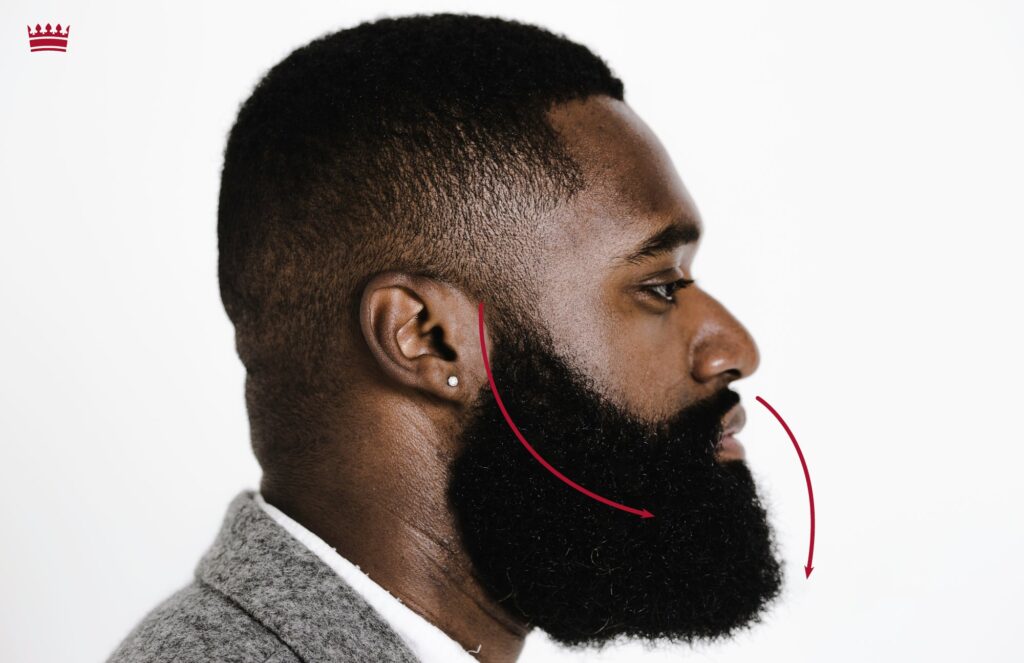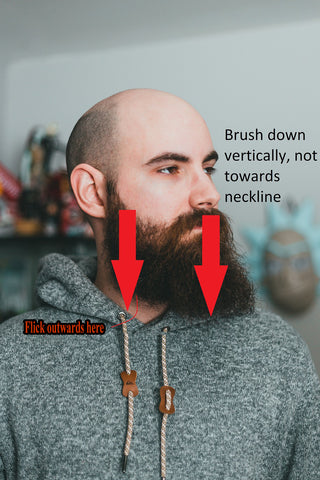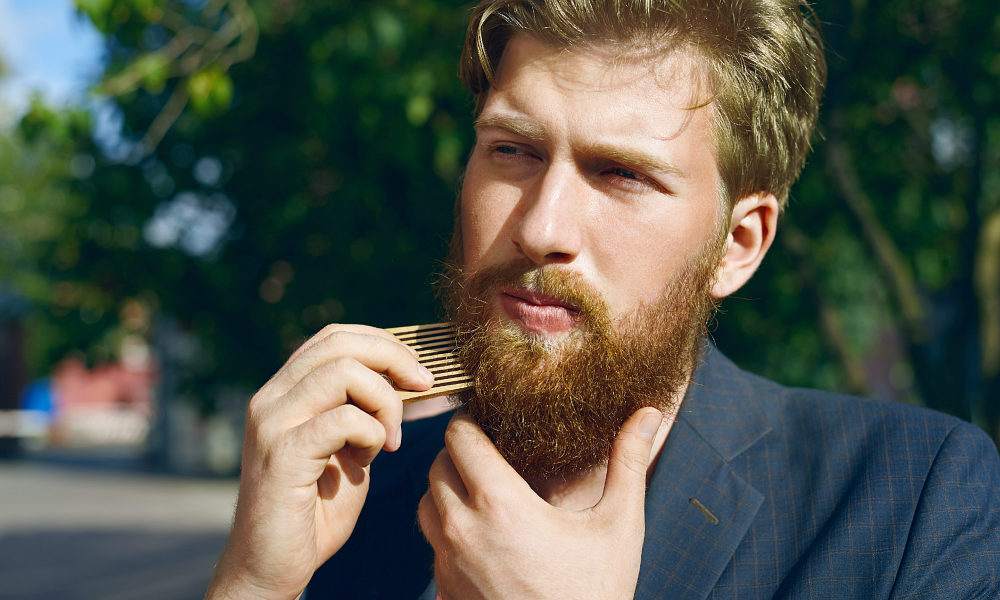In this article, we’ll discuss the proper technique for brushing your beard. You’ll learn about the benefits of brushing, how to choose the right brush, and step-by-step instructions for brushing your beard correctly. By the end of this article, you’ll have all the knowledge you need to keep your beard looking and feeling its best. So, let’s get started and transform your beard grooming routine!
The importance of brushing a beard
Having a beard is more than just growing facial hair; it’s a lifestyle and a statement of personal style. However, growing a beard is not without its challenges. One of the key factors in maintaining a healthy, attractive beard is proper brushing. Brushing your beard regularly not only keeps it looking neat and well-groomed but also promotes healthy growth and improves the overall appearance and texture of your beard.
Why brushing is necessary for beard maintenance
Brushing your beard serves a vital role in maintaining its health and appearance. Here are a few reasons why brushing is necessary:
-
Removes debris and tangles: Throughout the day, your beard can accumulate dirt, dust, and other particles. Brushing helps remove these debris, keeping your beard clean and preventing the buildup of bacteria. It also helps untangle knots and prevents the formation of dreaded beard dandruff.
-
Stimulates natural oils: Brushing your beard helps distribute the natural oils produced by your skin, known as sebum, throughout your beard. This prevents dryness, reduces itchiness, and promotes a healthier beard overall.
-
Improves blood circulation: Brushing stimulates blood flow to the hair follicles, which can help promote healthy beard growth and prevent hair loss.
-
Shapes and styles your beard: Regular brushing helps train your beard to grow in a desired direction, making it easier to shape and style. It also adds volume and enhances the overall appearance of your beard.
Benefits of brushing a beard
Proper brushing techniques yield several benefits for your beard:
-
Healthier beard: Brushing stimulates the follicles, improving blood circulation and promoting healthy beard growth.
-
Enhanced appearance: Regular brushing helps remove tangles, knots, and debris, giving your beard a clean and polished look.
-
Reduced itchiness: By distributing natural oils and moisturizing the skin beneath your beard, brushing reduces itchiness and dryness, making your beard more comfortable to grow and maintain.
-
Thicker and fuller beard: Brushing helps train your beard hairs to grow in a desired direction, giving the appearance of a fuller and more voluminous beard.
Next, we will explore how to choose the right beard brush for your needs.
Choosing the right beard brush
Choosing the right beard brush is essential to effectively groom and maintain your beard. The right brush will depend on factors such as your beard length and style. Here are some types of brushes for different beard lengths and styles:
-
Boar Bristle Brush: Boar bristle brushes are ideal for shorter beards or those with fine hair. The natural bristles help distribute oils and remove debris, giving your beard a healthy shine.
-
Combination Brush: Combination brushes have both boar bristles and nylon bristles. This type of brush is suitable for medium-length beards and provides both detangling and smoothing benefits.
-
Wide-Toothed Comb: If you have a long, dense beard, a wide-toothed comb may be more suitable. This type of comb helps prevent tangling and evenly distributes natural oils throughout your beard.
Considerations when selecting a beard brush include:
-
Bristle stiffness: The stiffness of the brush bristles will vary. Softer bristles are suitable for sensitive skin or shorter beards, while stiffer bristles are better for longer, thicker beards.
-
Handle material: A brush with a sturdy handle will allow for better control and ease of use. Look for brushes with handles made of materials like wood or bamboo for durability.
-
Size: Consider the size of the brush in relation to your beard. A smaller brush may be more suitable for a shorter beard, while a larger brush will cover more surface area and work better for longer, fuller beards.
-
Quality: Invest in a high-quality beard brush that will last longer and provide optimal grooming benefits. Cheap brushes may have bristle fall-out or be made of lower-quality materials.
Now that you have chosen the right beard brush, it’s crucial to prepare your beard before brushing.

Preparing your beard for brushing
Before you start brushing your beard, it’s important to prepare it properly. Here are a few steps to follow:
Washing and conditioning your beard
Before brushing, it’s recommended to wash your beard with a gentle beard shampoo or cleanser. This removes any dirt, product buildup, and excess oils from your beard, allowing your brush to glide smoothly through the hair.
After washing, apply a beard conditioner or oil to keep your beard moisturized and nourished. This step will make your beard softer and more manageable, making brushing easier and more effective.
Drying your beard before brushing
Ensure that your beard is completely dry before brushing. Wet hair is more prone to breakage, and brushing a wet beard can cause unnecessary stress on the hair follicles. Use a towel or a blow dryer on low heat to gently dry your beard before proceeding to the next step.
Now that your beard is clean and dry, let’s explore the proper techniques for brushing your beard.
Proper brushing techniques
Brushing your beard using the correct techniques will ensure optimal results. Here are some steps to follow:
Start from the bottom and work your way up
To prevent unnecessary pulling and breakage, start brushing your beard from the bottom. Begin at the neckline and work your way up, gradually moving toward the chin and cheeks. This technique prevents tangles from getting worse and allows for even distribution of natural oils.
Brush in the direction of hair growth
Brush your beard in the direction of hair growth, following the natural grain of your beard. This helps train your beard to grow in the desired direction, promoting a neater and more uniform appearance.
Use gentle strokes
Avoid aggressive or rough brushing, as it can damage the hairs and irritate the skin beneath your beard. Instead, use gentle, smooth strokes to ensure that you’re not causing unnecessary stress on the hair follicles.
Brush both the surface and underneath the beard
Make sure to brush both the surface of your beard and the underneath portion. This helps remove tangles and distributes natural oils evenly throughout your beard. It also helps keep your skin healthy and prevents the buildup of dead skin cells.
Focus on untangling knots and removing debris
As you brush, pay special attention to any tangles or knots in your beard. Use your brush or comb to gently untangle the hairs, starting from the ends and working your way up. Additionally, make sure to brush out any debris that may have accumulated in your beard throughout the day.
Next, we will discuss the frequency of brushing and factors that influence it.

Frequency of brushing
The frequency of brushing your beard will depend on various factors, including the length and density of your beard, personal preference, and daily activities. Here are some guidelines to help you determine how often you should brush your beard:
How often should you brush your beard?
In general, it’s recommended to brush your beard at least once or twice a day. This helps remove tangles, distribute natural oils, and keep your beard looking neat and well-groomed. However, if you have a shorter beard or are facing time constraints, brushing every other day may suffice.
Factors that influence the frequency of brushing
-
Beard length: Longer beards require more frequent brushing to prevent tangling and keep the hairs in place. Shorter beards may not require as much brushing.
-
Beard style: Different beard styles may require varying amounts of brushing. If you have a more intricate or sculpted beard style, you may need to brush it more often to maintain its shape.
-
Daily activities: If you engage in activities that cause your beard to become dirty or tangled, such as exercising outdoors or working in a dusty environment, you may need to brush your beard more frequently to remove debris and prevent knotting.
-
Personal preference: Ultimately, the frequency of brushing your beard should be based on your personal preference and the needs of your beard. Some individuals enjoy the ritual of brushing and may choose to do it more often, while others may prefer a more minimalistic approach.
Remember, consistency is key when it comes to beard brushing. Establishing a routine and sticking to it will yield better results and help you maintain a well-groomed and healthy beard.
Now let’s discuss the dos and don’ts of beard brushing to ensure you’re getting the most out of your grooming routine.
Dos and don’ts of beard brushing
To make the most of your beard brushing routine, it’s important to follow certain guidelines. Here are some dos and don’ts to keep in mind:
Do use a clean brush
Keep your beard brush clean and free from debris, dead skin cells, and excess oils. A dirty brush can transfer unwanted elements back into your beard, affecting its cleanliness and overall health. Clean your brush regularly by rinsing it with warm water and mild soap, and allow it to air dry completely.
Don’t brush a wet beard
As mentioned earlier, brushing a wet beard can cause unnecessary stress on the hair follicles and lead to breakage. Ensure that your beard is completely dry before brushing to minimize damage.
Do be patient and gentle
Avoid rushing through the brushing process. Take your time and be gentle with your beard. Rushing or being too rough can cause tangling, breakage, and discomfort. Embrace a patient and gentle approach to ensure the best results.
Don’t over-brush
While brushing is essential, over-brushing can cause frizziness and damage to your beard. Brushing your beard excessively can strip away natural oils and lead to dryness. Find a balance and avoid excessive brushing to maintain a healthy beard.
Do brush your mustache separately
Your mustache requires its own special attention. Brush it separately from your beard to ensure it stays neat and well-groomed. This will also help prevent any unruly hairs from intruding on your upper lip.
Don’t neglect the neckline
The neckline often gets neglected when it comes to beard brushing. Brushing the neckline helps prevent beard dandruff and ensures a neat appearance. Include the neckline in your brushing routine for optimal beard maintenance.
Following these dos and don’ts will help you maintain a healthy and attractive beard. Next, let’s explore some additional tips to enhance your beard brushing routine.

Additional tips for effective beard brushing
To take your beard brushing routine to the next level, consider these additional tips:
Using beard oil or balm before brushing
Applying beard oil or balm before brushing helps soften the hairs and make them more manageable. These products also nourish the skin beneath your beard, improve the overall health of your beard, and enhance the effectiveness of brushing.
Combing vs. brushing: which one to choose?
While brushing is the primary method for beard maintenance, combing can also be useful, especially for longer beards. Combs help detangle and shape the beard, while brushes are better at distributing natural oils. Depending on your beard’s length and style, you may choose to use a combination of both brushing and combing.
Trimming stray or split ends
Regular trimming is essential for maintaining a healthy and well-groomed beard. As you brush your beard, keep an eye out for split ends or any stray hairs that may need trimming. This will ensure that your beard looks its best and prevent split ends from spreading further along the hair shaft.
By incorporating these additional tips into your routine, you can improve the effectiveness of your beard brushing and achieve a well-groomed and impressive beard. However, there are certain common mistakes to avoid while brushing a beard.
Common mistakes to avoid while brushing a beard
To ensure you’re getting the most out of your beard brushing routine, avoid these common mistakes:
Rough or aggressive brushing
Brushing your beard too aggressively can cause damage to the hair follicles and lead to breakage. Be gentle and patient while brushing, allowing the bristles to glide smoothly through your beard.
Using the wrong type of brush
Using a brush that is not suitable for your beard type or length can lead to ineffective grooming and potential damage. Make sure to choose a brush that is appropriate for your specific needs, as we discussed earlier.
Brushing too frequently
While brushing is essential for beard maintenance, overdoing it can strip away natural oils and cause dryness. Find the right balance and avoid excessive brushing.
Neglecting to clean the brush
A dirty brush can transfer dirt, debris, and bacteria back into your beard, counteracting the benefits of brushing. Make sure to clean your brush regularly to maintain its hygiene.
By avoiding these mistakes, you can maximize the benefits of your beard brushing routine. However, even with proper brushing techniques, you may encounter some common beard brushing issues. Let’s explore how to troubleshoot these issues.

Troubleshooting common beard brushing issues
Here are some tips to troubleshoot common beard brushing issues:
Dealing with beard dandruff
If you notice flaking or itching in your beard, you may be dealing with beard dandruff, also known as “beardruff.” To address this issue, focus on keeping your beard clean and well-moisturized. Use a beard shampoo or cleanser designed specifically for dandruff-prone skin. Additionally, incorporate a beard oil or balm into your routine to moisturize and nourish your skin and beard.
Addressing beard itch
If your beard feels itchy, it may be a sign of dryness or irritation. Regularly applying beard oil or balm before brushing can alleviate itchiness and provide relief. Additionally, ensure that you are washing your beard regularly with a gentle cleanser and not over-brushing, as these practices can contribute to dryness and itchiness.
Tackling tangles and knots
If you have a longer or denser beard, you may encounter tangles and knots. To tackle these issues, be patient and use your brush or comb to gently work through the tangles, starting from the ends and working your way up. Applying a beard oil or balm before brushing can also help soften the hairs and make them easier to manage.
The role of brushing in beard styling
Brushing your beard not only maintains its health but also plays a crucial role in shaping and styling. Here’s how brushing contributes to different aspects of beard styling:
Creating a desired shape and volume
Brushing your beard allows you to shape it according to your desired style. By brushing in the direction of hair growth and using gentle strokes, you can train your beard hairs to stay in place and achieve a specific shape and volume.
Training your beard with brushing
Regular brushing helps train your beard hairs to grow in the desired direction. By brushing against the grain or sweeping the hairs to the side, you can influence the way your beard grows and enhance its appearance.
Enhancing beard texture and appearance
Brushing promotes even distribution of natural oils, which can improve the texture and appearance of your beard. It adds a healthy shine and reduces frizz, making your beard look more well-maintained and attractive.
By incorporating proper brushing techniques into your beard grooming routine, you can achieve the desired shape, volume, and texture for your beard. But what about caring for your beard brush itself?

Caring for your beard brush
Your beard brush deserves proper care and maintenance to ensure long-lasting use and optimal performance. Here are some tips for cleaning and maintaining your beard brush:
Cleaning and maintaining your beard brush
-
Remove any loose hairs from the brush bristles by gently pulling them out with your fingers.
-
Rinse the brush bristles under warm water to remove any dirt or debris.
-
Apply a small amount of mild soap or shampoo to the bristles and gently lather them.
-
Use your fingers or a soft-bristled brush to clean between the bristles.
-
Rinse the brush thoroughly to remove any soap residue.
-
Shake off the excess water and gently pat the bristles with a towel to remove excess moisture.
-
Leave the brush to air dry completely before storing it. Avoid using a blow dryer or placing the brush near a heat source, as this can damage the bristles.
Replacing your beard brush when necessary
Over time, the bristles of your beard brush may wear out or become ineffective. If you notice significant bristle fall-out, fraying, or loss of stiffness, it’s time to replace your brush. A worn-out brush may not provide the desired grooming benefits and may even cause damage to your beard.
By caring for your beard brush properly and replacing it when necessary, you can ensure that it remains in optimal condition and continues to serve you well.
Now let’s revisit the benefits of regular beard brushing to reinforce the importance of this grooming practice.
The benefits of regular beard brushing
Regular beard brushing yields numerous benefits for your beard and overall grooming routine. Here are a few key advantages:
Promoting beard growth
By stimulating blood circulation to the hair follicles, brushing helps promote healthy beard growth. The gentle massaging action of the brush can stimulate dormant hair follicles and encourage them to produce new, healthy hairs.
Improving blood circulation to the hair follicles
Brushing your beard improves blood circulation to the hair follicles, delivering essential nutrients and oxygen to promote healthy hair growth. This increased blood flow can also prevent hair loss and help maintain a fuller, thicker beard.
Stimulating natural oils for a healthier beard
Brushing your beard helps distribute natural oils throughout the hair strands. This keeps your beard moisturized and nourished, preventing dryness, itchiness, and beard dandruff. Regular brushing also helps prevent the pores from becoming clogged, which can contribute to acne and other skin issues.
Enhancing the overall look and feel of your beard
Regular brushing keeps your beard looking neat, well-groomed, and attractive. It helps remove tangles, knots, and debris, giving your beard a clean and polished appearance. Brushing also adds volume and enhances the texture of your beard, making it feel softer and more manageable.
By incorporating regular beard brushing into your grooming routine, you can enjoy a healthier, fuller, and more attractive beard.
Conclusion
Properly brushing your beard is crucial for maintaining its health, appearance, and style. Choosing the right brush, preparing your beard properly, and following the correct brushing techniques are essential for achieving a well-groomed and impressive beard. By being consistent, avoiding common mistakes, troubleshooting any issues that arise, and celebrating the benefits of regular beard brushing, you can take your beard game to the next level.
At BeardsDude.com, we understand the importance of proper beard care and grooming. We provide valuable resources, expert advice, and product recommendations to help you on your beard journey. Join our community today and embark on an exciting journey toward a better beard. Together, let’s explore the multifaceted world of beards and celebrate the art of beard grooming.
